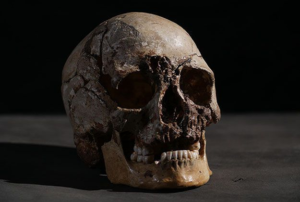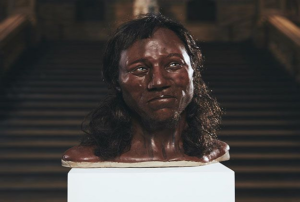 3D printing and scanning technology has been used many times to provide a face for modern human remains that can’t otherwise be identified. But researchers also use 3D printing to throw back the curtain of history, giving us an idea of how famous historical figures like Jesus of Nazareth, author Jonathan Swift, and the Lady of Cao might have actually looked. Many times, these projects end up surprising us – how else would we have known that Scottish king Robert the Bruce had leprosy if not for a 3D facial reconstruction? The latest surprise unearthed by historians concerns Cheddar Man, the first modern Briton to be discovered who lived in southwest England 10,000 years ago.
3D printing and scanning technology has been used many times to provide a face for modern human remains that can’t otherwise be identified. But researchers also use 3D printing to throw back the curtain of history, giving us an idea of how famous historical figures like Jesus of Nazareth, author Jonathan Swift, and the Lady of Cao might have actually looked. Many times, these projects end up surprising us – how else would we have known that Scottish king Robert the Bruce had leprosy if not for a 3D facial reconstruction? The latest surprise unearthed by historians concerns Cheddar Man, the first modern Briton to be discovered who lived in southwest England 10,000 years ago.
The remains of the ancient Mesolithic man, the oldest nearly complete skeleton of Homo sapiens ever found in Britain, were discovered back in 1903 inside popular tourist attraction Gough’s Cave in Cheddar Gorge, Somerset. According to Dr. Selina Brace, a researcher of ancient DNA at Britain’s Natural History Museum, the cave environment helped preserve his remains.
Brace explained, “In the cave you have a really nice, cool, dry, constant environment, and that basically prevents the DNA from breaking down.”

Known as ‘Cheddar Man’ after the area in southwest England where his skeleton was discovered in a cave in 1903, the ancient man has been brought to life through the first ever full DNA analysis of his remains. [Image: AFP]
These findings suggest that people in northern Europe having lighter skin happened more recently than scientists originally deduced. At the end of the last Ice Age, Cheddar Man’s tribe migrated to Britain, and his ancient DNA was linked to other individuals in modern-day Hungary, Luxembourg, and Spain. About 10% of indigenous British ancestry can be linked to that population.Professor Chris Stringer, Research Leader in Human Origins at the Natural History Museum, said, “It is very surprising that a Brit 10,000 years ago could have that combination of very blue eyes but really dark skin.”
“Until recently it was always assumed that humans quickly adapted to have paler skin after entering Europe about 45,000 years ago. Pale skin is better at absorbing UV light and helps humans avoid vitamin D deficiency in climates with less sunlight,” said Dr. Tom Booth, a postdoctoral researcher working with the museum’s human remains collection to investigate human adaptation to changing environments.
“‘He is just one person, but also indicative of the population of Europe at the time. They had dark skin and most of them had pale colored eyes, either blue or green, and dark brown hair. Cheddar Man subverts people’s expectations of what kinds of genetic traits go together.
“It seems that pale eyes entered Europe long before pale skin or blond hair, which didn’t come along until after the arrival of farming. He reminds us that you can’t make assumptions about what people looked like in the past based on what people look like in the present, and that the pairings of features we are used to seeing today aren’t something that’s fixed.”
To access Cheddar Man’s DNA, scientists drilled a 2 mm hole into his skull and removed bone powder, which luckily contained enough genetic information that the team was able to analyze it and reconstruct the face.
- [Images: The Trustees of the Natural History Museum, London]
“To extract ancient DNA from a human or animal what you’re looking for is a dense bone which might have protected the DNA inside it as much as possible,” explained Dr. Brace. “We used to use leg bones or teeth as the thick bones and enamel keep DNA quite intact, but in the last two years we’ve shifted to using the petrous, or inner ear bone, which is the densest bone in the human body.”

Model makers Adrie (L) and Alfons Kennis pose with their full face reconstruction model, made from the skull of Cheddar Man. [Image: AFP]
Professor Stringer said, “I first studied ‘Cheddar Man’ more than 40 years ago, but could never have believed that we would one day have his whole genome – the oldest British one to date! To go beyond what the bones tell us and get a scientifically-based picture of what he actually looked like is a remarkable (and from the results quite surprising!) achievement.”
A documentary about Cheddar Man, and the 3D reconstruction, will be aired on Sunday, February 18th, titled First Brit: Secrets of the 10,000 Year Old Man.
Alfons says in the documentary, “It’s a story all about migrations throughout history. It maybe gets rid of the idea that you have to look a certain way to be from somewhere. We are all immigrants.”

Museum scientists Dr. Selina Brace, Prof. Ian Barnes, Prof. Chris Stringer, and Dr. Silvia Bello pose with the reconstruction of Cheddar Man [Image: Tom Barnes, Channel 4]
Subscribe to Our Email Newsletter
Stay up-to-date on all the latest news from the 3D printing industry and receive information and offers from third party vendors.
Print Services
Upload your 3D Models and get them printed quickly and efficiently.
You May Also Like
Could 3D Printing for Biocomputing Make Wetware Aware?
As an AI arms race consumes ever more electricity, and every ChatGPT search query costs $0.36, the search for new ways of computing has intensified. One answer could be in better...
Bambu Lab Launches Software to Manage 3D Printer Fleets—No Cloud Needed
Bambu Lab has introduced a new software tool, Bambu Farm Manager, designed to help users manage large fleets of 3D printers over a local network, without relying on the cloud....
Consolidation in AM: How 2025 Is Shaping the Industry’s New Normal
The first half of 2025 has been marked by a clear shift in the additive manufacturing (AM) industry. Companies are no longer just focused on developing new tech by themselves....
3D Printing News Briefs, July 2, 2025: Copper Alloys, Defense Manufacturing, & More
We’re starting off with metals in today’s 3D Printing News Briefs, as Farsoon has unveiled a large-scale AM solution for copper alloys, and Meltio used its wire-laser metal solution to...



































